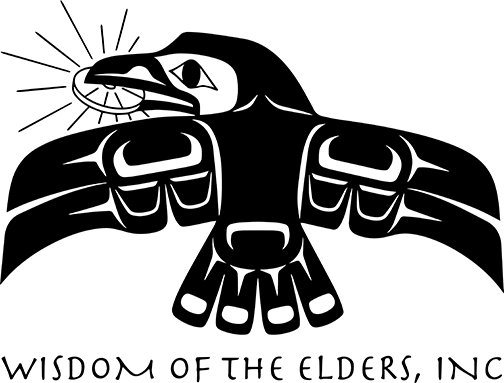Historical Introduction:
The Chinook
with Arlie Neskahi
Arlie Neskahi:
Welcome to Wisdom of the Elders. I’m Arlie Neskahi.
Taucum’s canoes were powered by twenty-five sturdy men. Cold rain dripped off the rims of their woven conical hats, but they were cheerfully singing and rowing, as they cut through the choppy waters of the Columbia River. Taucum was on his way to visit “basisiyuks ” — the blanket men, who had come overland, and not – like the Bostons – on a sailing ship, seeking furs. Instead, they traded cloth blankets for food, and very little else. But Taucum was going to see for himself.
It was February 20 th, 1806. The Corps of Discovery had built a fort in the Clatsop forest two miles south of today’s Youngs Bay in Oregon. They had settled in for a soggy four months, studying the local flora and fauna, making salt from the shores of the Pacific Ocean, and collecting data on the surrounding people.
The Lower Chinook, or Chinook proper, inhabited the north side of the Columbia River. The Willapa and the Wahkiakum lived nearby. Lewis and Clark’s closest neighbors on the south side were the Clatsops and the Kathlamets. Today, these five tribes comprise the Chinook nation.
Gary Johnson:
Welcome to everyone here today. This is going to be an important four days…
Neskahi:
Gary Johnson, chairman of the Chinook nation, welcomes visitors to a celebration at their home office set up in an old school in Chinook, Washington.
Johnson:
The commemoration that we’re having is just a celebration of Chinook survival. We’re going stronger every day.
Neskahi:
The story of Chinook survival is a long, unfinished tale, full of triumphs and disappointments. It starts hundreds of years ago when Chinookan peoples migrated slowly down the Columbia, to find a home in the rainforests on the coast. Their mastery of water navigation allowed the Chinook to hunt the whale and other seagoing mammals, as well as trade throughout the region for shells, roots, elk-skin armor and slaves. By the time Lewis and Clark arrived, the Chinook had already been trading with American and British merchants for over a decade. And they controlled the traffic of foreign goods up river as far as Celilo falls. The Chinook were at the height of their wealth and power. But within a few decades, everything changed. Gary Johnson,
Johnson:
The first treaty signings were in august of 1851. They were a series of what were called the Anson Dart treaties with each of our tribes. These were sent back to the U.S. Senate and were not ratified. So they are technically today waiting to be ratified.
Neskahi:
As non-Indian settlement along the rivers increased, a single village on a Willapa Bay point near bay center, Washington became the last outpost of the Chinook, until now.
Johnson:
On january 3 rd, 2001, we had a ceremony in Washington D.C., where they officially recognized us again. There was a change of administration, and they took that recognition away 18 months later.
Neskahi:
Despite the lack of federal recognition, the Chinook continue to act as a sovereign nation.
Johnson:
All I want to say is what beginning. What a great morning we had together. I invite you let’s honor our elders as we go to the food line…
Neskahi:
With the morning ceremonies concluded, guests are invited to a free salmon feast under a rain-soaked tent outside the hall. From the look of the pride on everyone’s faces, it seems the Chinook are alive and well.
For Wisdom of the Elders, this is Arlie Neskahi.


